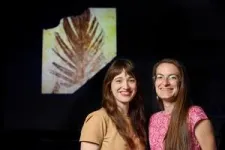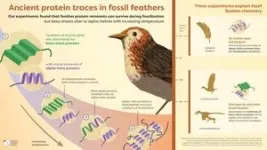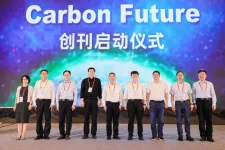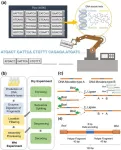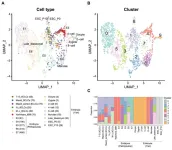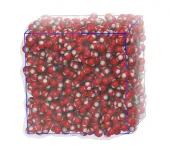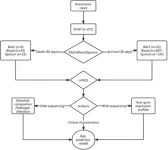(Press-News.org) Palaeontologists at University College Cork (UCC) in Ireland have discovered X-ray evidence of proteins in fossil feathers that sheds new light on feather evolution.
Previous studies suggested that ancient feathers had a different composition to the feathers of birds today. The new research, however, reveals that the protein composition of modern-day feathers was also present in the feathers of dinosaurs and early birds, confirming that the chemistry of feathers originated much earlier than previously thought.
The research, published today in Nature Ecology and Evolution, was led by palaeontologists Dr Tiffany Slater and Prof. Maria McNamara of UCC’s School of Biological, Earth, and Environmental Science, who teamed with scientists based at Linyi University (China) and the Stanford Synchrotron Radiation Lightsource (USA).
The team analysed 125-million-year-old feathers from the dinosaur Sinornithosaurus and the early bird Confuciusornis from China, plus a 50-million-year-old feather from the USA.
“It’s really exciting to discover new similarities between dinosaurs and birds,” Dr Slater says. “To do this, we developed a new method to detect traces of ancient feather proteins. Using X-rays and infrared light we found that feathers from the dinosaur Sinornithosaurus contained lots of beta-proteins, just like feathers of birds today.”
To help interpret the chemical signals preserved in the fossil feathers, the team also ran experiments to help understand how feather proteins break down during the fossilization process.
“Modern bird feathers are rich in beta-proteins that help strengthen feathers for flight,” Dr Slater says.
“Previous tests on dinosaur feathers, though, found mostly alpha-proteins. Our experiments can now explain this weird chemistry as the result of protein degradation during the fossilization process. So although some fossil feathers do preserve traces of the original beta-proteins, other fossil feathers are damaged and tell us a false narrative about feather evolution.”
This research helps answer a long-standing debate about whether feather proteins, and proteins in general, can preserve in deep time.
Prof. Maria McNamara, senior author on the study, said
“Traces of ancient biomolecules can clearly survive for millions of years, but you can’t read the fossil record literally because even seemingly well-preserved fossil tissues have been cooked and squashed during fossilization. We’re developing new tools to understand what happens during fossilization and unlock the chemical secrets of fossils. This will give us exciting new insights into the evolution of important tissues and their biomolecules. “
ENDS
END
Dinosaur feathers reveal traces of ancient proteins
New method reveals similarities between dinosaurs and birds
2023-09-21
ELSE PRESS RELEASES FROM THIS DATE:
Researchers develop first method to study microRNA activity in single cells
2023-09-21
MicroRNAs are small molecules that regulate gene activity by binding to and destroying RNAs produced by the genes. More than 60% of all human genes are estimated to be regulated by microRNAs, therefore it is not surprising that these small molecules are involved in many biological processes including diseases such as cancer. To discover the function of a microRNA, it is necessary to find out exactly which RNAs are targeted by it. While such methods exist, they require a lot of material typically in order of millions of cells, to ...
Nanoparticles made from plant viruses could be farmers’ new ally in pest control
2023-09-21
A new form of agricultural pest control could one day take root—one that treats crop infestations deep under the ground in a targeted manner with less pesticide.
Engineers at the University of California San Diego have developed nanoparticles, fashioned from plant viruses, that can deliver pesticide molecules to soil depths that were previously unreachable. This advance could potentially help farmers effectively combat parasitic nematodes that plague the root zones of crops, all while minimizing costs, pesticide use and environmental toxicity.
Controlling infestations caused by root-damaging nematodes has long been a challenge in agriculture. One reason is that the types of pesticides ...
Social vs. language role: researchers question function of two brain areas
2023-09-21
A research team led by Prof. LIN Nan from the Institute of Psychology of the Chinese Academy of Sciences found that during sentence processing, the neural activity of two canonical language areas, i.e., the left ventral temporoparietal junction (vTPJ) and the lateral anterior temporal lobe (lATL), is associated with social-semantic working memory rather than language processing per se.
The study was published in Nature Human Behaviour on Sept. 21.
Language and social cognition are two deeply interrelated abilities of the human species, but have traditionally been studied ...
Inauguration ceremony of carbon future
2023-09-21
On September 17th, 2023, Carbon Future, an international interdisciplinary journal sponsored by Tsinghua University, has been officially inaugurated.
Carbon Future is an open access, peer-reviewed and international interdisciplinary journal that reports carbon-related materials and processes, including carbon materials, catalysis, energy conversion and storage, as well as low carbon emission process and engineering. The journal is published quarterly by Tsinghua University Press, and publicly released on SciOpen, an internationally digital ...
Revolutionizing data storage: DNA movable-type system paves the way for sustainable data storage technology
2023-09-21
In a groundbreaking study published in Engineering, researchers have developed a revolutionary method for data storage using DNA. The paper titled “Engineering DNA Materials for Sustainable Data Storage Using a DNA Movable-Type System” introduces a novel approach that utilizes DNA fragments, referred to as “DNA movable types,” for data writing, thereby eliminating the need for costly and environmentally hazardous DNA synthesis.
DNA molecules have long been recognized as green materials ...
NIH center grant bolsters male contraceptive research
2023-09-21
Weill Cornell Medicine has received a three-year, nearly $6 million grant to lead one of three national contraceptive research centers. The grant from the Eunice Kennedy Shriver National Institute of Child Health and Human Development, part of the National Institutes of Health, will fund the Weill Cornell Medicine Contraception Development Research Center. Led by Drs. Jochen Buck and Lonny Levin, both professors of pharmacology at Weill Cornell Medicine, the center will focus on developing an on-demand male contraceptive.
“It’s an honor to be selected for a second time for this award,” Dr. Levin ...
Supportive later-life social relationships mediate the risk of severe frailty in adults who had negative childhood experiences
2023-09-21
INDIANAPOLIS -- Frailty is a serious concern in later-life adults due to its association with additional health risks including disability, falls, hospitalization and mortality. The prevalence of frailty has risen over time; about 15 percent of those aged 65 years and older are considered frail.
In one of the first studies to analyze the mediating effects of social relationships in the relationship between childhood experiences and frailty, Regenstrief Research Scientist Monica M. Williams-Farrelly, PhD, has found ...
Towards a better understanding of early human embryonic development
2023-09-21
The onset of embryo-specific gene transcription, also known as embryonic genome activation (EGA), is a crucial step in the developmental journey of an organism. Although EGA has been studied to some extent in mice, human EGA remains largely unexplored, mainly due to the lack of novel in vitro cell models and ethical restrictions on the usage of human embryos. Thus, cell models resembling the human blastomere stage—when the embryo undergoes a cell duplication process—are necessary to study the earliest stages of human EGA and understand the events that occur during early embryonic development.
To ...
Evaluating the shear viscosity of different water models
2023-09-21
Water is one of the most abundant substances on Earth and partakes in countless biological, chemical, and ecological processes. Thus, understanding its behavior and properties is essential in a wide variety of scientific and applied fields. To do so, researchers have developed various water models to reproduce the behavior of bulk water in molecular simulations. While these simulations can provide valuable insights into the specific properties of water, selecting an appropriate model for the system under study is crucial. ...
Precision treatment for pneumonia care: metagenomic sequencing takes the lead
2023-09-21
Community-acquired pneumonia (CAP) is a major infectious disease worldwide and contributes to high mortality and massive economic burden. Hospital mortality among the severe CAP (SCAP) remains high, ranging from 25% to more than 50%.
Early identification of patients at high risk of death is essential for improving patient outcomes. However, predicting outcomes in patients with SCAP is challenging, as the disease is complex and influenced by various factors, including the types of pathogen causing the infection, the host immune response, and underlying medical conditions.
In this study published in eBioMedicine (a Lancet publication), a team led by Dr. Jinmin Ma, BGI Genomics Infection ...
LAST 30 PRESS RELEASES:
New expert guidance urges caution before surgery for patients with treatment-resistant constipation
Solar hydrogen can now be produced efficiently without the scarce metal platinum
Sleeping in on weekends may help boost teens’ mental health
Study: Teens use cellphones for an hour a day at school
After more than two years of war, Palestinian children are hungry, denied education and “like the living dead”
The untold story of life with Prader-Willi syndrome - according to the siblings who live it
How the parasite that ‘gave up sex’ found more hosts – and why its victory won’t last
When is it time to jump? The boiling frog problem of AI use in physics education
Twitter data reveals partisan divide in understanding why pollen season's getting worse
AI is quick but risky for updating old software
Revolutionizing biosecurity: new multi-omics framework to transform invasive species management
From ancient herb to modern medicine: new review unveils the multi-targeted healing potential of Borago officinalis
Building a global scientific community: Biological Diversity Journal announces dual recruitment of Editorial Board and Youth Editorial Board members
Microbes that break down antibiotics help protect ecosystems under drug pollution
Smart biochar that remembers pollutants offers a new way to clean water and recycle biomass
Rice genes matter more than domestication in shaping plant microbiomes
Ticking time bomb: Some farmers report as many as 70 tick encounters over a 6-month period
Turning garden and crop waste into plastics
Scientists discover ‘platypus galaxies’ in the early universe
Seeing thyroid cancer in a new light: when AI meets label-free imaging in the operating room
Neutrophil-to-lymphocyte ratio may aid risk stratification in depressive disorder
2026 Seismological Society of America Annual Meeting
AI-powered ECG analysis offers promising path for early detection of chronic obstructive pulmonary disease, says Mount Sinai researchers
GIMM uncovers flaws in lab-grown heart cells and paves the way for improved treatments
Cracking the evolutionary code of sleep
Medications could help the aging brain cope with surgery, memory impairment
Back pain linked to worse sleep years later in men over 65, according to study
CDC urges ‘shared decision-making’ on some childhood vaccines; many unclear about what that means
New research finds that an ‘equal treatment’ approach to economic opportunity advertising can backfire
Researchers create shape-shifting, self-navigating microparticles
[Press-News.org] Dinosaur feathers reveal traces of ancient proteinsNew method reveals similarities between dinosaurs and birds

